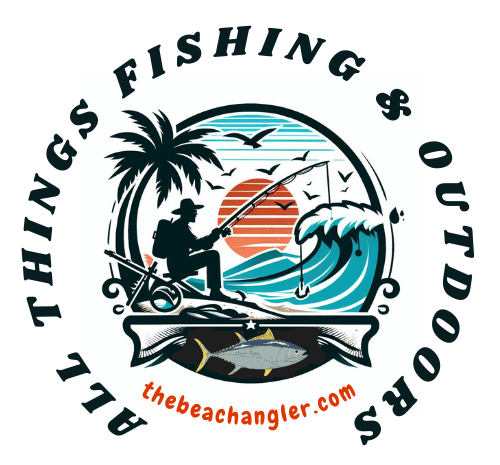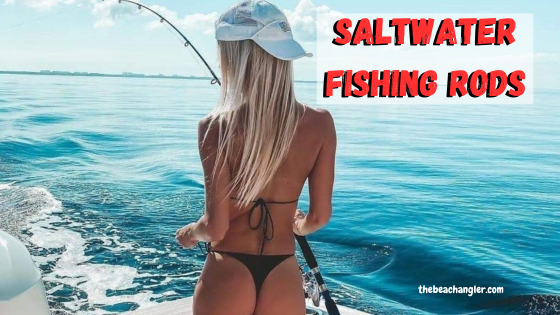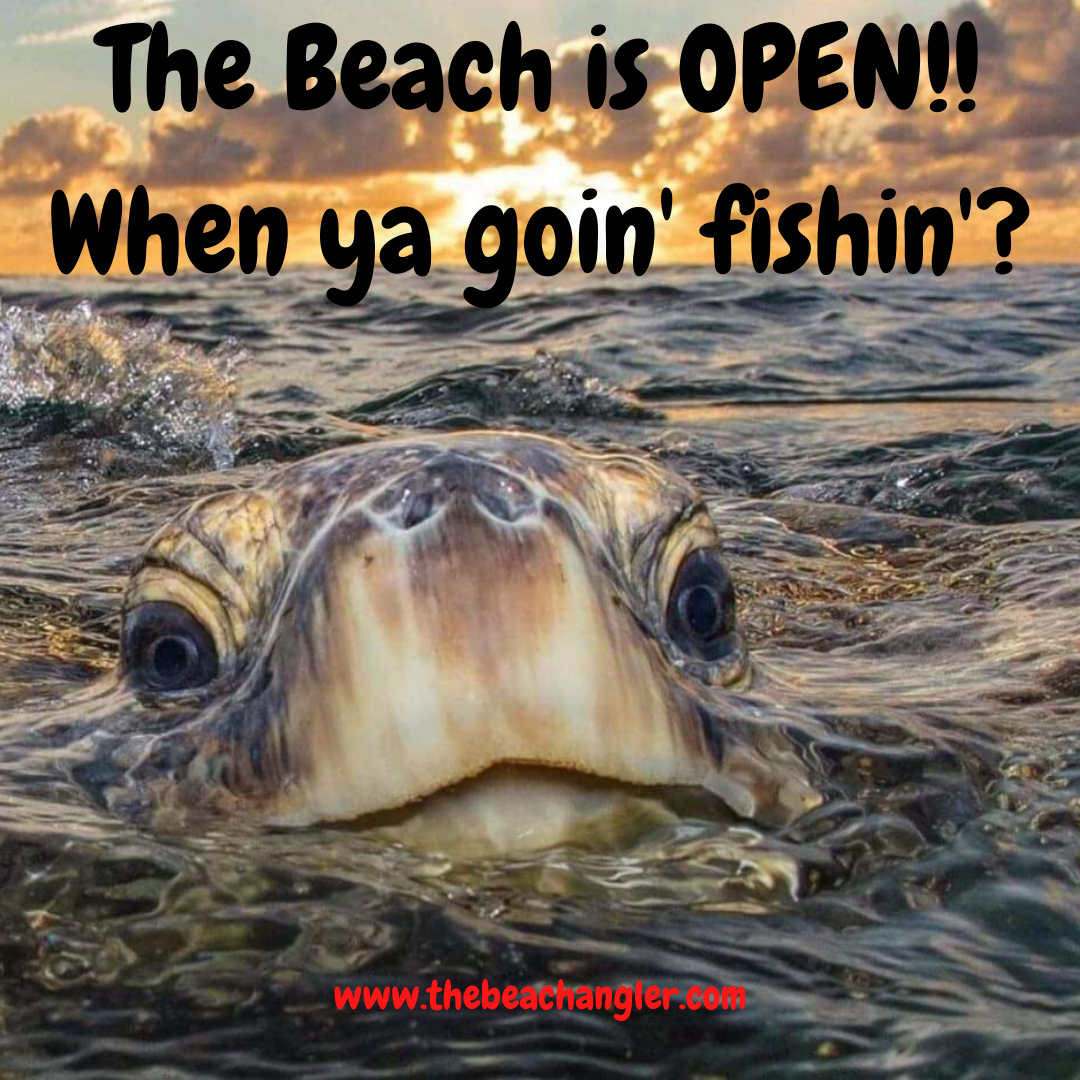Last updated on June 7th, 2024 at 10:03 pm
If you’re an angler who loves saltwater fishing, then you know how important it is to have the right equipment. One of the most important pieces of equipment is your fishing rod. Saltwater fishing rods are designed to handle the unique challenges, and environment, of fishing in the ocean, including strong currents, big waves, corrosive saltwater, and powerful fish.
QUICK LOOK:
Saltwater fishing rods are designed to handle the unique challenges of fishing in the ocean, including strong currents, big waves, corrosive saltwater, and powerful fish. There are three basic types of saltwater fishing rods: Casting, Spinning, and Trolling. Understanding the different styles and materials of saltwater rods is essential for choosing the right rod for your fishing needs. When selecting a saltwater fishing rod, consider the type of fishing you will be doing, the size and strength of the fish you are targeting, and your personal preferences.
Understanding what makes a good saltwater fishing rod is essential for any angler who wants to consistently catch fish and have gear that survives the harsh marine environment. These rods are typically longer and heavier than freshwater rods, and they are designed to handle the unique demands of saltwater fishing.
Saltwater fishing rods are made from materials that are resistant to corrosion, such as graphite, fiberglass, and stainless steel, and also come in a variety of styles, including spinning, casting, trolling, and surf rods.
Important factors to consider when selecting a saltwater fishing rod include the type of fishing you will be doing, the size and strength of the fish you are targeting, and your personal preferences. Some popular brands of saltwater rods include Shimano, Penn, Tsunami, and Daiwa.
With so many options available, it’s important to do your research and choose a rod that meets your specific needs. Follow along, and we’ll take a look at everything you need to know about saltwater fishing rods, including the different types, materials, and components.
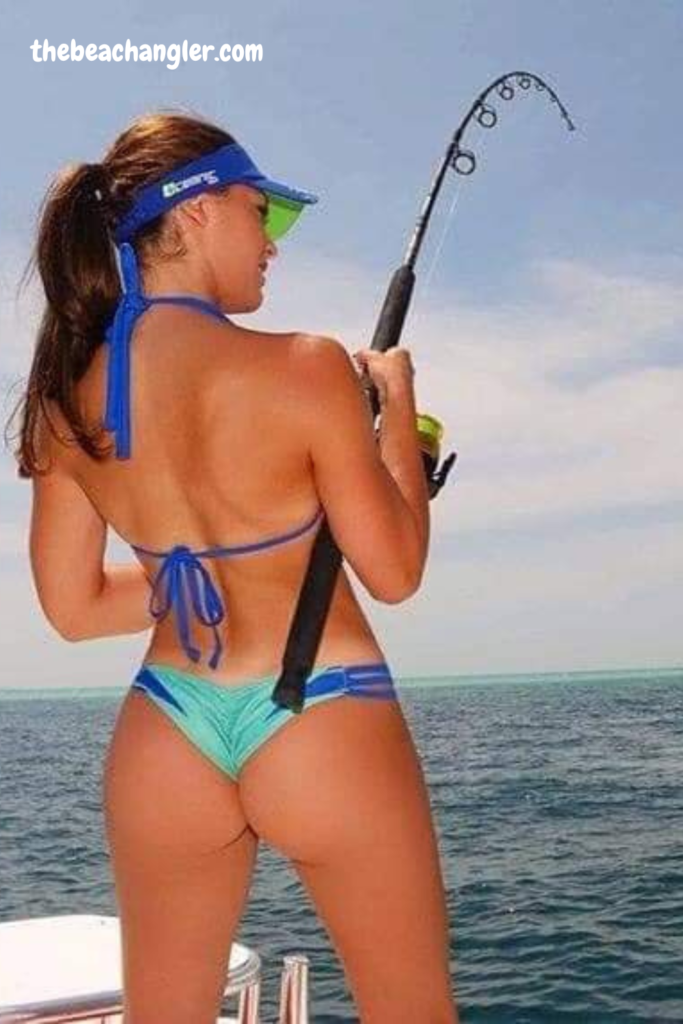
| Saltwater Casting Rod | Saltwater Spinning Rod | Saltwater Trolling Rod |
|---|---|---|
 | 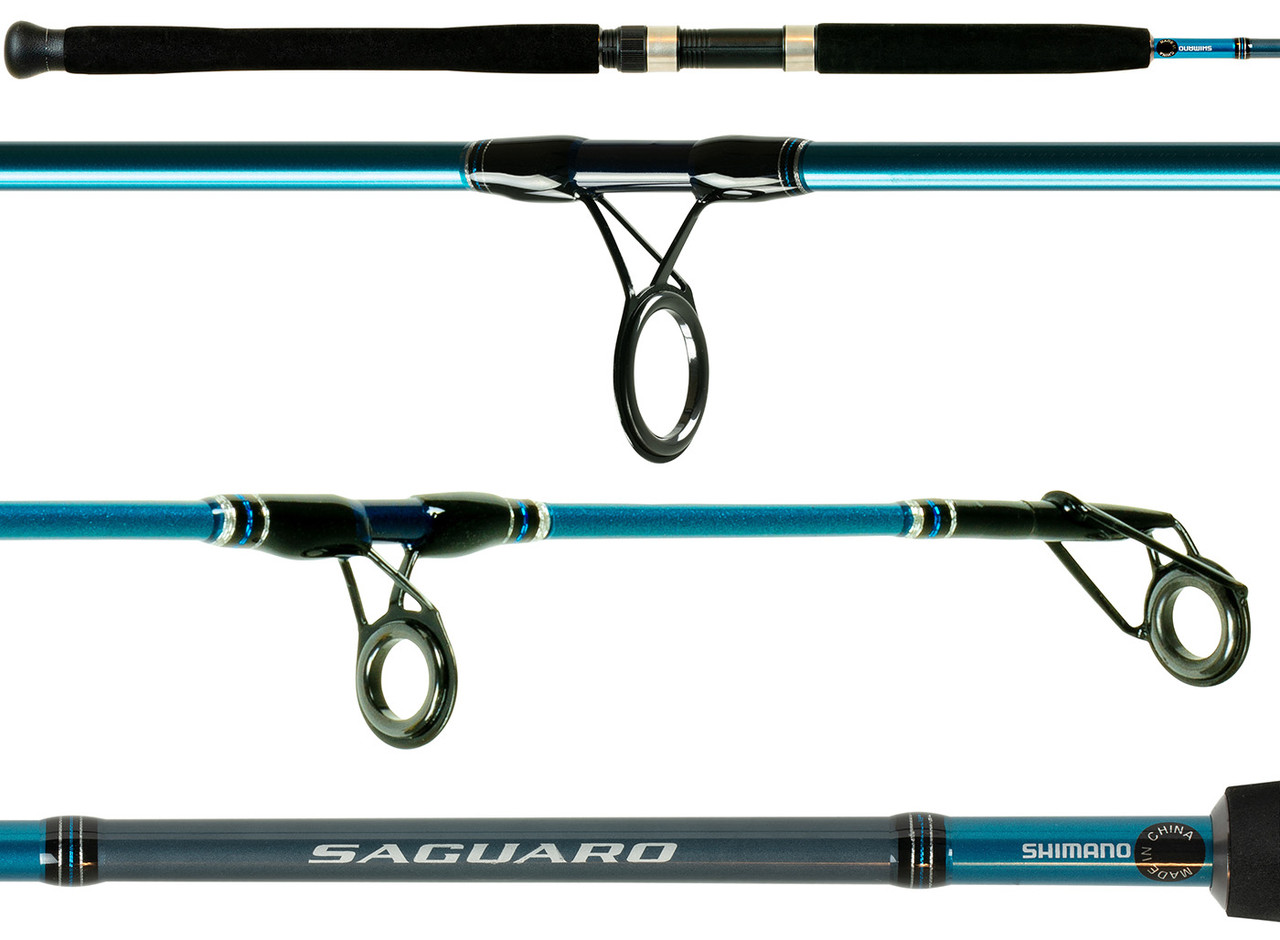 |  |
| St. Croix Avid Casting Rod | Shimano Siguaro Spinning Rod | Okuma Makaira Trolling Rod |
| SEE REVIEWS | SEE REVIEWS | SEE REVIEWS |
Saltwater Fishing Rods vs Freshwater Fishing Rods
One of the main differences between saltwater fishing rods and freshwater fishing rods is the materials used to make them. Saltwater rods are typically made from materials that can withstand the corrosive effects of saltwater, such as graphite or fiberglass. In contrast, freshwater rods may be made from materials like bamboo or other types of wood.
Another difference is the length and strength of the rod. Saltwater fishing rods tend to be longer and stronger than their freshwater counterparts, which allows them to handle larger fish and rougher conditions. Additionally, saltwater rods often have larger guides and reel seats to accommodate the heavier lines and reels used in saltwater fishing.
Understanding Saltwater Fishing Rods
When it comes to fishing, the type of rod you use can make all the difference. Saltwater fishing rods, in particular, are designed to handle the unique challenges that come with fishing in saltwater environments. Here’s what you need to know about these specialized rods.
Choosing the Right Saltwater Fishing Rod
When choosing a saltwater fishing rod, there are several factors to consider. One of the most important is the type of fishing you’ll be doing. Different rods are designed for different types of fishing, such as trolling, casting, or jigging.
You’ll also want to consider the size and strength of the fish you’ll be targeting. A heavier rod with a higher power rating will be better suited for larger fish, while a lighter rod with a lower power rating may be more appropriate for smaller fish.
Finally, you’ll want to consider the length and action of the rod. Longer rods provide greater casting distance and leverage, while shorter rods offer greater accuracy and control. The action of the rod refers to how much it bends when pressure is applied. A fast-action rod bends mostly at the tip, while a slow-action rod bends throughout the entire length of the rod.
When it comes to saltwater fishing, choosing the right fishing rod can make all the difference. Here are seven things to consider when selecting a saltwater fishing rod:
1. Where and How You Will Be Fishing?
Will you be fishing from a boat or shore? Will you be fishing in the bay, in the surf, or offshore? For Example, If you will be fishing with artificials in the bay your rod will be different from someone bottom fishing around wrecks, oil platforms, and other structures offshore.
2. What You Will Be Fishing for?
If you will be tossing topwaters for red drum on the flats, you will need a different rod than if you were dropping big baits off the beach for sharks. Likewise, if you will be trolling offshore for billfish like sailfish or marlin, you will need an entirely different type of saltwater fishing rod.
3. Material
The material of your fishing rod is an important factor to consider. Fiberglass is the most widely used saltwater fishing rod material and is strong, durable, and flexible. Graphite is another popular option that is lightweight and sensitive, making it great for detecting bites.
New-generation composite materials are also available and offer a combination of the benefits of both fiberglass and graphite.
4. Length and Power
The length and power of your fishing rod will depend on the type of fishing you plan to do. Longer rods are better for casting longer distances, while shorter rods offer more control and accuracy. Power refers to the strength of the rod and its ability to handle heavy fish. Light power rods are best for smaller fish, while heavy power rods are better for larger fish.
5. Action
The action of a fishing rod refers to how much the rod bends when pressure is applied. Fast-action rods bend mostly in the top third of the rod, while slow-action rods bend throughout the entire length of the rod. Medium-action rods fall somewhere in between. The action of your rod will depend on the type of fishing you plan to do.
6. Handle
The handle of your fishing rod is an important factor to consider as it affects your comfort and control while fishing. Cork and EVA foam are popular handle materials as they provide a comfortable grip and good sensitivity. Some handles may also have additional features such as trigger grips or fighting butts.
7. Your Budget
Your budget is also an important factor to consider when choosing a saltwater fishing rod. While high-end rods may offer better performance and durability, there are also many affordable options available that still offer great quality, value, and performance.
Overall, choosing the right saltwater fishing rod depends on your personal preferences and the type of fishing you plan to do. By considering the material, length and power, action, handle, and budget, you can find a fishing rod that best suits your needs.
Types of Saltwater Fishing Rods
There are three main types of saltwater fishing rods: spinning rods, casting rods, and trolling rods. Each type has its unique features and is designed for specific types of fishing.
Spinning Rods
Spinning rods are a popular choice for saltwater fishing because they are versatile and easy to use. They are designed to be used with spinning reels and are ideal for catching smaller fish.
Some of the advantages of using spinning rods for saltwater fishing include:
- They are lightweight and easy to handle.
- Great for casting light lures and baits.
- Ideal for catching smaller fish like trout, redfish, and snook.
If you’re looking for a good spinning rod for saltwater fishing, consider the Shimano Teramar TMS-X70MH. This rod is made from high-quality graphite and is designed to be lightweight and durable.

Casting Rods
Casting rods are another popular choice for saltwater fishing. They are designed to be used with baitcasting reels and are ideal for catching larger fish.
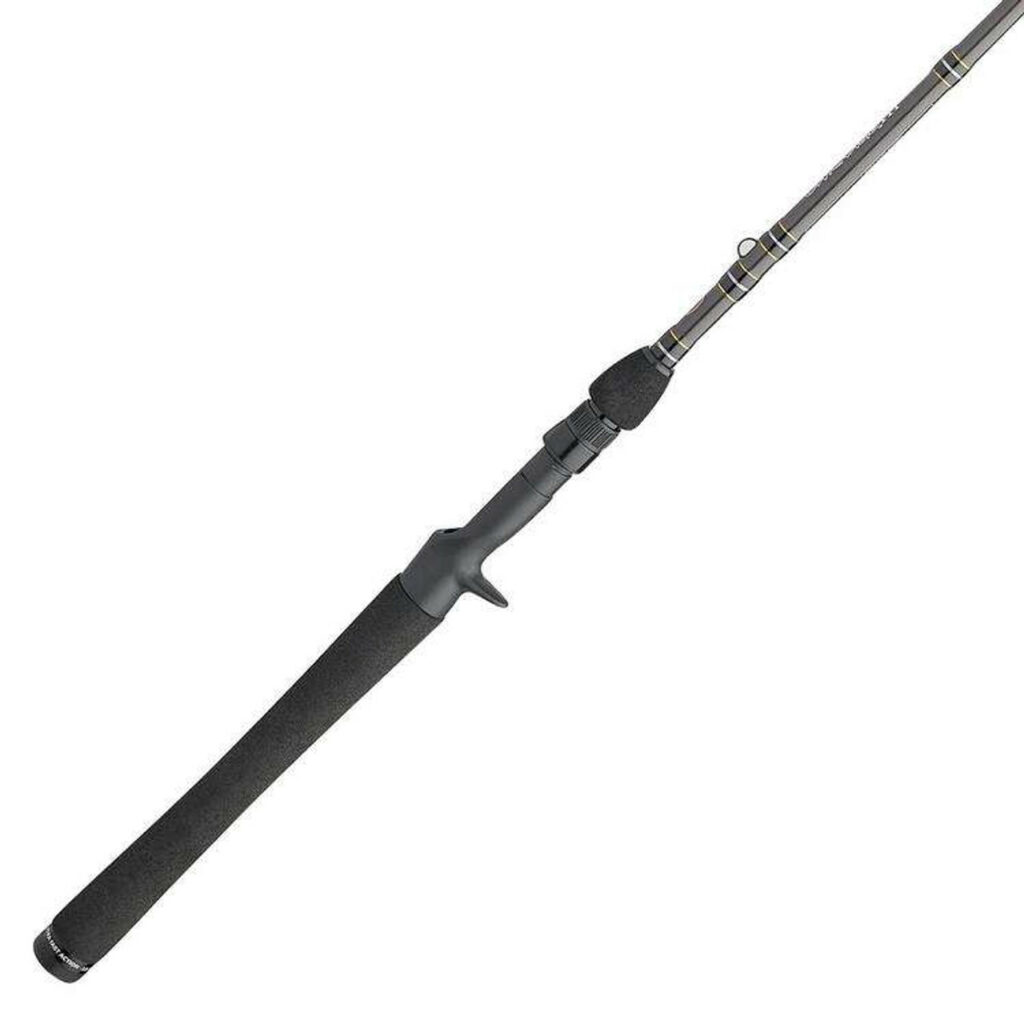
Some of the advantages of using casting rods for saltwater fishing include:
- They are great for casting heavy lures and baits.
- Better for catching larger fish like tarpon, tuna, and marlin.
- Provides more accuracy and control than spinning rods.
If you’re looking for a good casting rod for saltwater fishing, consider the Penn Carnage III Casting Rod. This rod is made from high-quality graphite and is designed to be strong and durable.
Trolling Rods
Trolling rods are designed to be used with trolling reels and are ideal for catching fish while trolling. They are typically longer than other types of rods and have a slower action.
Some of the advantages of using trolling rods for saltwater fishing include:
- Great for catching larger fish like tuna, marlin, and sailfish.
- They allow you to cover more water than other types of rods.
- Provide more power than other types of rods.
If you’re looking for a good trolling rod for saltwater fishing, consider the Okuma Cedros CJ-65S. This rod is made from high-quality graphite and is designed to be strong and durable.
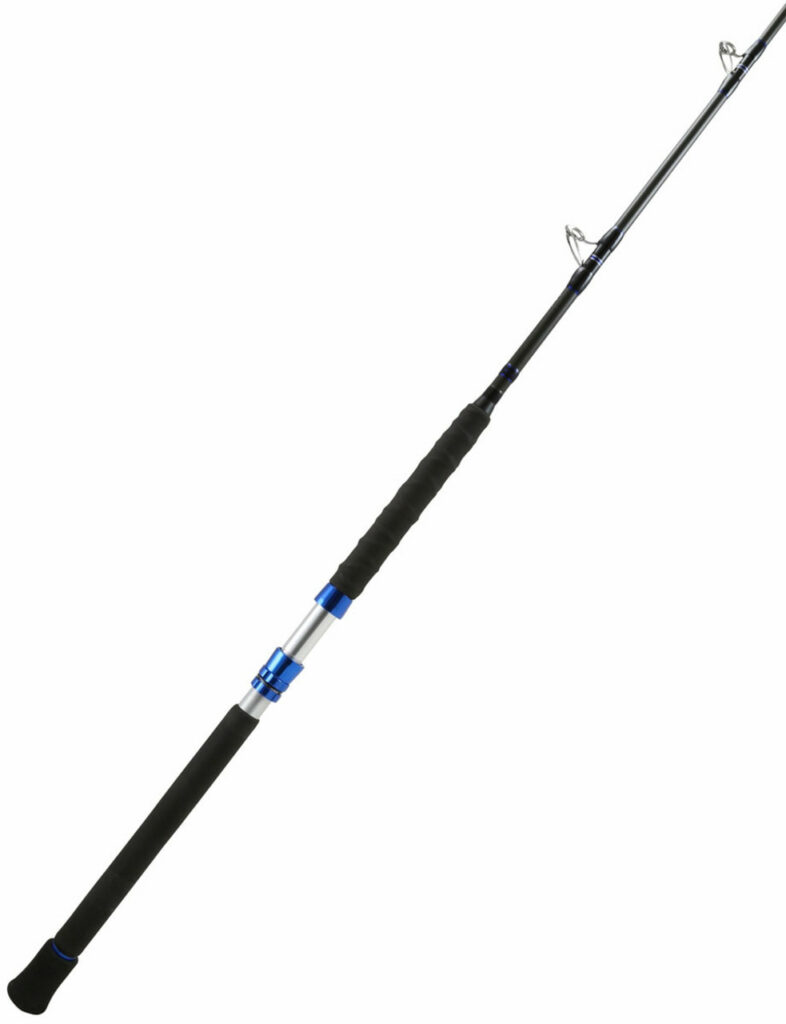
Saltwater Fishing Rod Materials
Saltwater fishing rods can be made from a variety of materials, including graphite, fiberglass, and composite materials. Each material has its unique properties that make it suitable for different types of fishing.
Graphite Rods
Graphite rods are lightweight and sensitive, making them a popular choice among anglers. They are ideal for catching smaller fish like trout, redfish, and snook.
Some of the advantages of using graphite rods for saltwater fishing include:
- They are lightweight and easy to handle.
- Provide excellent sensitivity.
- Great for casting light lures and baits.
If you’re looking for a good graphite rod for saltwater fishing, consider the St. Croix Avid Inshore Spinning Rod. This rod is made from high-quality graphite and is designed to be lightweight and sensitive.
Fiberglass Rods
Fiberglass rods are strong and durable, making them a popular choice among anglers who want a rod that can handle larger fish. They are ideal for catching larger fish like tarpon, tuna, and marlin.
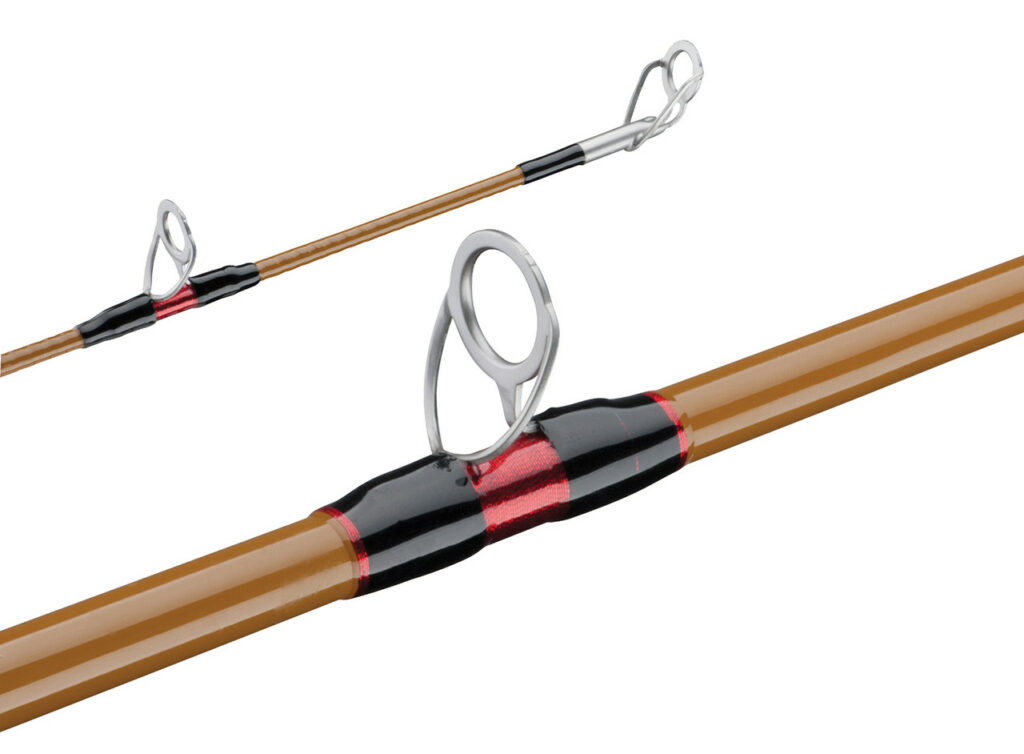
Some of the advantages of using fiberglass rods for saltwater fishing include:
- They provide more power than other types of rods.
- Can handle heavier lures and baits.
- Great for catching larger fish.
If you’re looking for a good fiberglass rod for saltwater fishing, consider the Ugly Stik Tiger Elite Casting Rod. This rod is made from high-quality fiberglass and is designed to be strong and durable.
Composite Rods
Composite rods are made from a combination of materials, typically graphite or fiberglass with an outer layer of carbon fiber. This makes them strong, lightweight, and sensitive.
Some of the advantages of using composite rods for saltwater fishing include:
- They provide excellent sensitivity.
- Can handle heavier lures and baits.
- Good for when you are targeting larger fish.
If you’re looking for a good composite rod for saltwater fishing, consider the Daiwa Saltiga Travel Spinning Rod. This rod is made from high-quality composite materials and is designed to be strong yet lightweight.

Saltwater Fishing Rod Components
Saltwater fishing rods consist of several components that work together to create an effective tool for catching fish.
Reel Seats
There are various types of reel seats available for saltwater fishing rods, each designed to accommodate different reel types and provide varying levels of sensitivity, strength, and comfort. Both spinning and casting reel seats play a crucial role in the overall performance of the fishing rod. Here are some common types of reel seats for saltwater fishing:
1. Graphite Reel Seats:
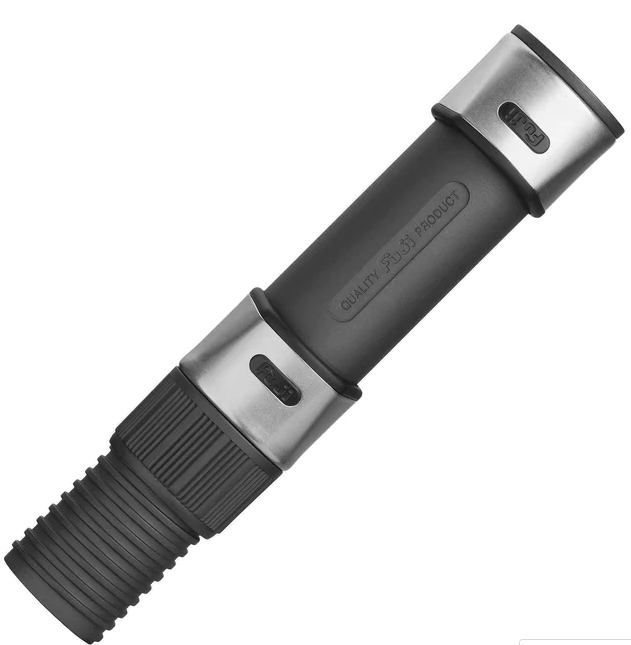
- Lightweight and corrosion-resistant.
- Good sensitivity and generally cost-effective.
- Best For Light to medium-duty applications.
2. Aluminum Reel Seats:
- Strong and corrosion-resistant.
- Durable and suitable for heavy-duty saltwater fishing.
- Best For Heavy spinning applications, big game fishing.
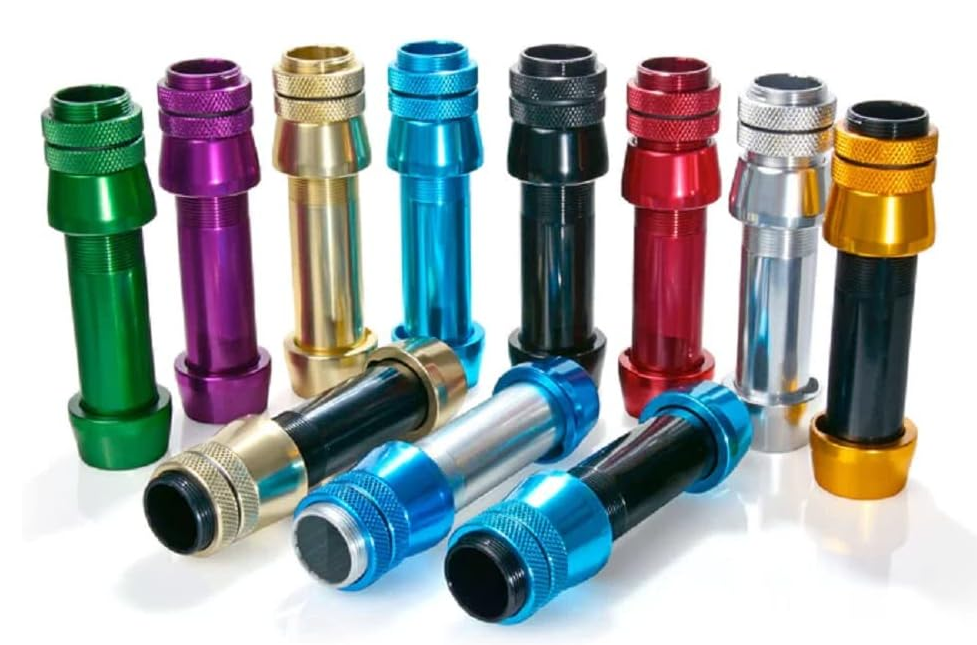
3. Carbon Fiber Reel Seats:

- Lightweight and strong.
- Enhanced sensitivity and durability.
- Versatile use in various saltwater conditions.
4. Trigger Reel Seats:
- Features a trigger-shaped design for the placement of the index finger.
- Offers better control and comfort during casting.
- Best For Baitcasting rods and reels, especially for larger species.
Choosing the right reel seat depends on the specific fishing conditions, target species, and personal preferences in terms of sensitivity, weight, and comfort. Always consider the overall balance of the rod and reel combination for optimal performance.
Guides
Guides are the small loops that run along the length of the rod and help guide the fishing line. They are typically made from metal or ceramic and come in a variety of sizes and shapes. Saltwater fishing rod guides are made of corrosion-resistant materials like stainless steel and titanium.
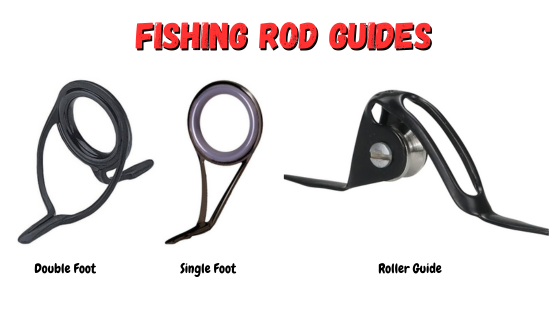
Single-foot guides are lightweight and ideal for spinning rods, while double-foot guides are stronger and better suited for casting rods. Roller guides are designed to reduce friction on the line and are ideal for trolling rods.
Handles
Handles are the part of the rod that you hold onto while fishing. They can be made from a variety of materials, including cork, EVA foam, and synthetic materials.
Cork handles are lightweight and provide a good grip, while EVA foam handles are more durable and provide more cushioning. Synthetic handles are typically the most durable and can be made to look like cork or EVA foam.
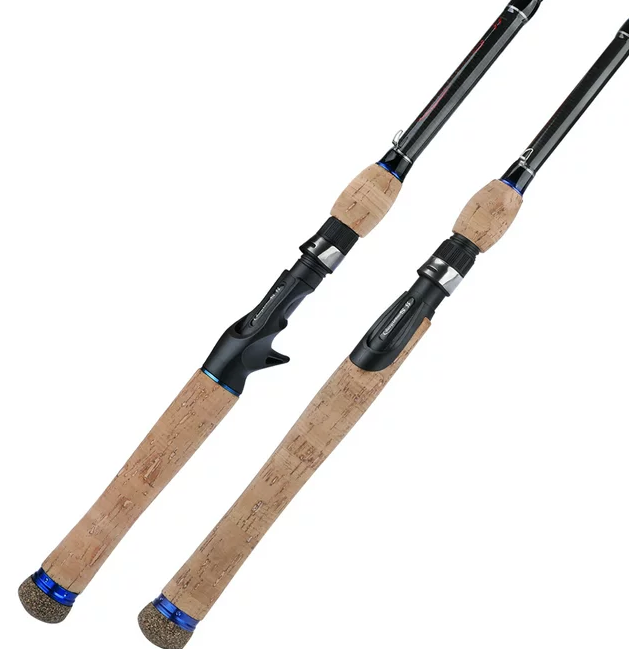
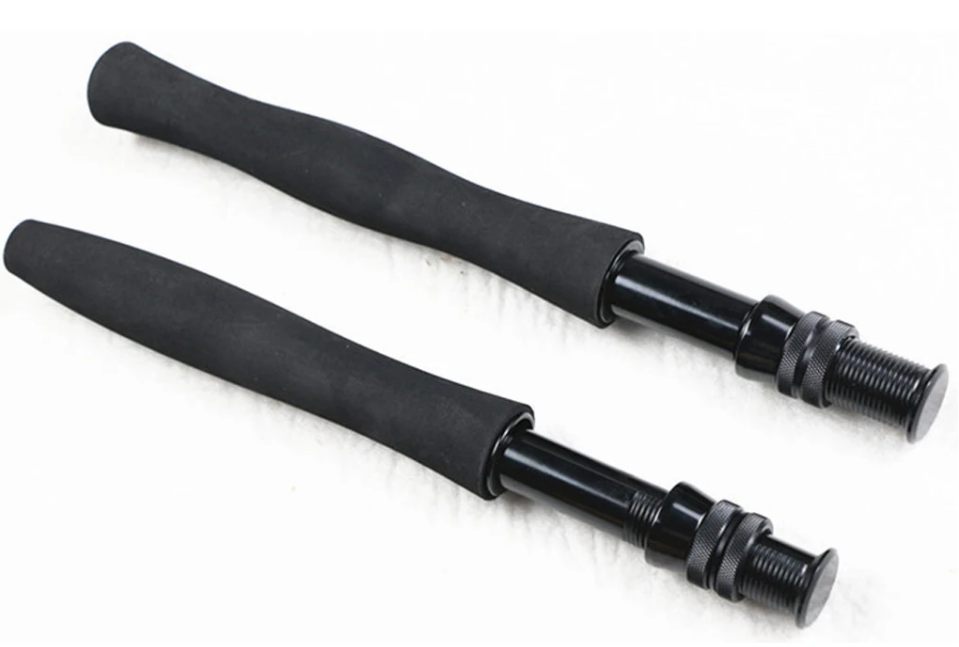
Rod Blank
Rod blanks, as mentioned earlier, are primarily graphite, fiberglass, or of composite construction.
Examples of Top Saltwater Fishing Rods
Saltwater Spinning Rods
| Shimano Saguaro | Penn Battalion II | St. Croix Mojo Salt |
|---|---|---|
 |  |  |
| This rod offers great sensitivity and strength and has a variety of lengths and action ratings available. | These rods provide maximum durability with their lightweight construction and stainless steel guides. | American made with high-quality materials and is designed to handle the toughest saltwater conditions. |
| SEE REVIEWS | SEE REVIEWS | SEE REVIEWS |
Saltwater Trolling Rods
| Okuma Makaira Roller Guide Trolling Rod | TackleDirect Platinum Hook Tuna Stick | Shimano Tallus Roller Fishing Rod | Penn Rampage Trolling Rod |
|---|---|---|---|
 | 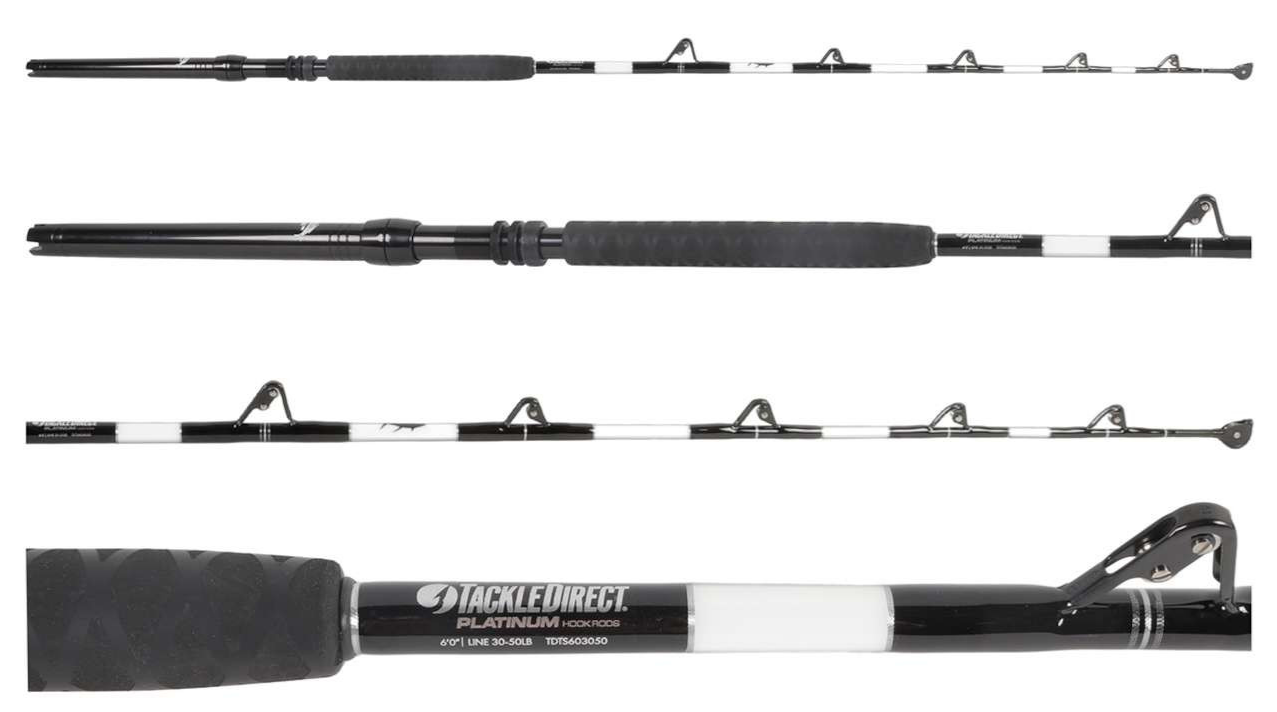 | 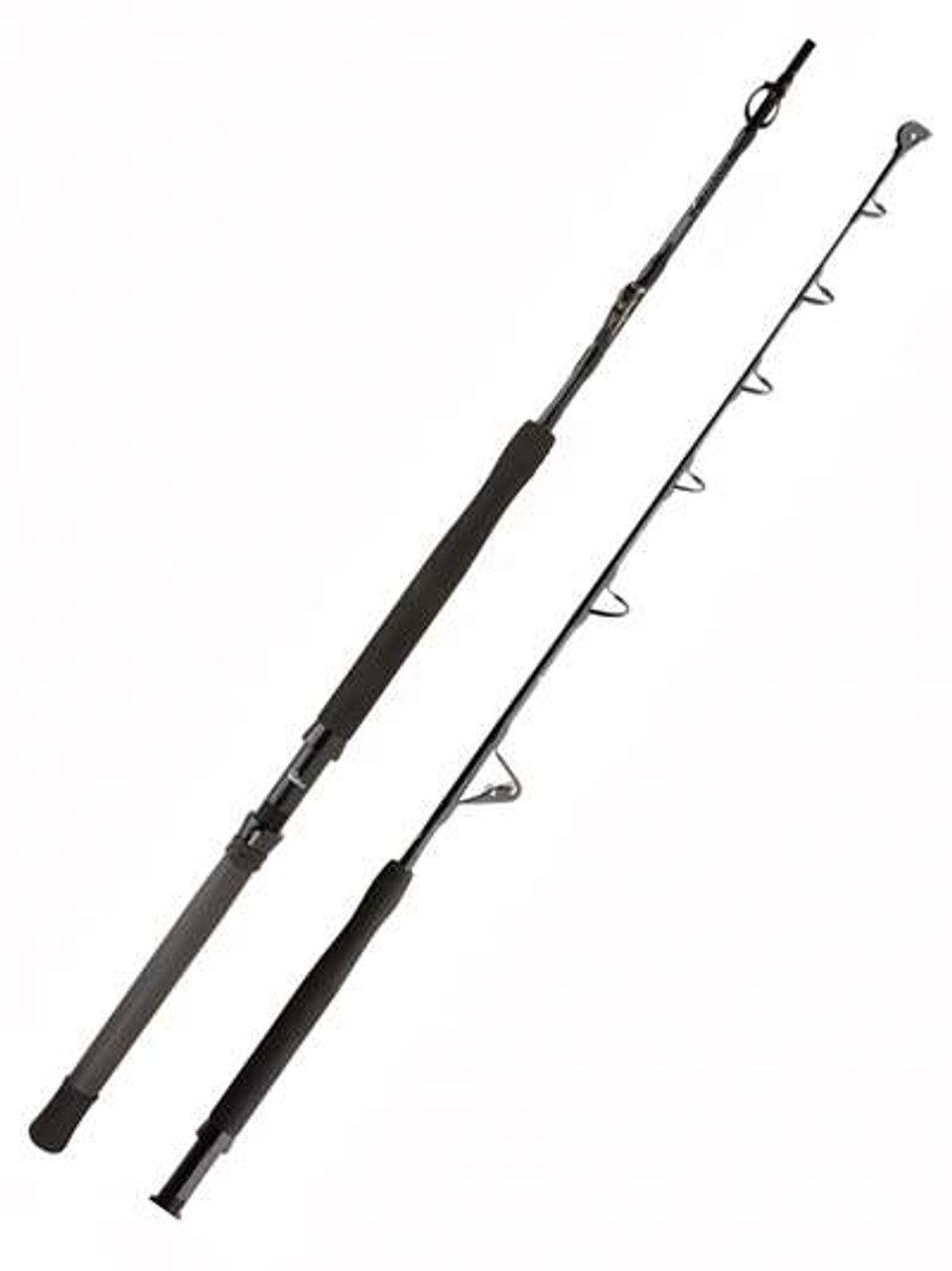 | 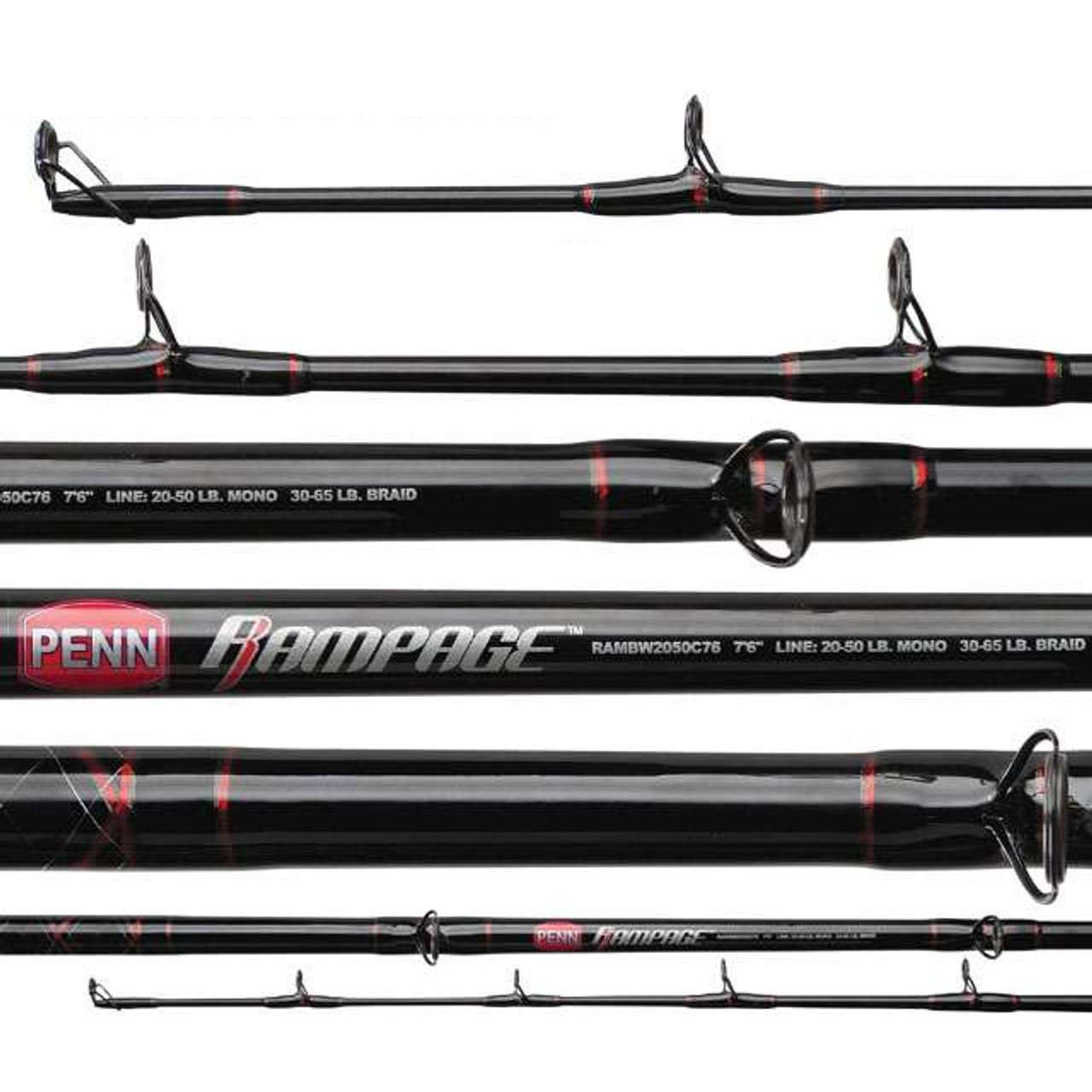 |
| Designed for big game fishing and features a heavy-duty roller guide system that helps prevent line tangles. It is available in different lengths and power ratings. | This rod is made with high-quality materials and features a durable EVA foam grip handle. It is also available in different lengths and power ratings. | Designed for offshore trolling and features a powerful graphite blank construction that provides excellent sensitivity and strength. | This rod is made with a durable graphite composite blank and features stainless steel guides with aluminum oxide inserts that help reduce friction and improve casting distance. |
| SEE REVIEWS | SEE REVIEWS | SEE REVIEWS | SEE REVIEWS |
Saltwater Casting Rods
| Ugly Stik GX2 | Daiwa Tatula | St. Croix Avid Inshore | Shimano Teramar |
|---|---|---|---|
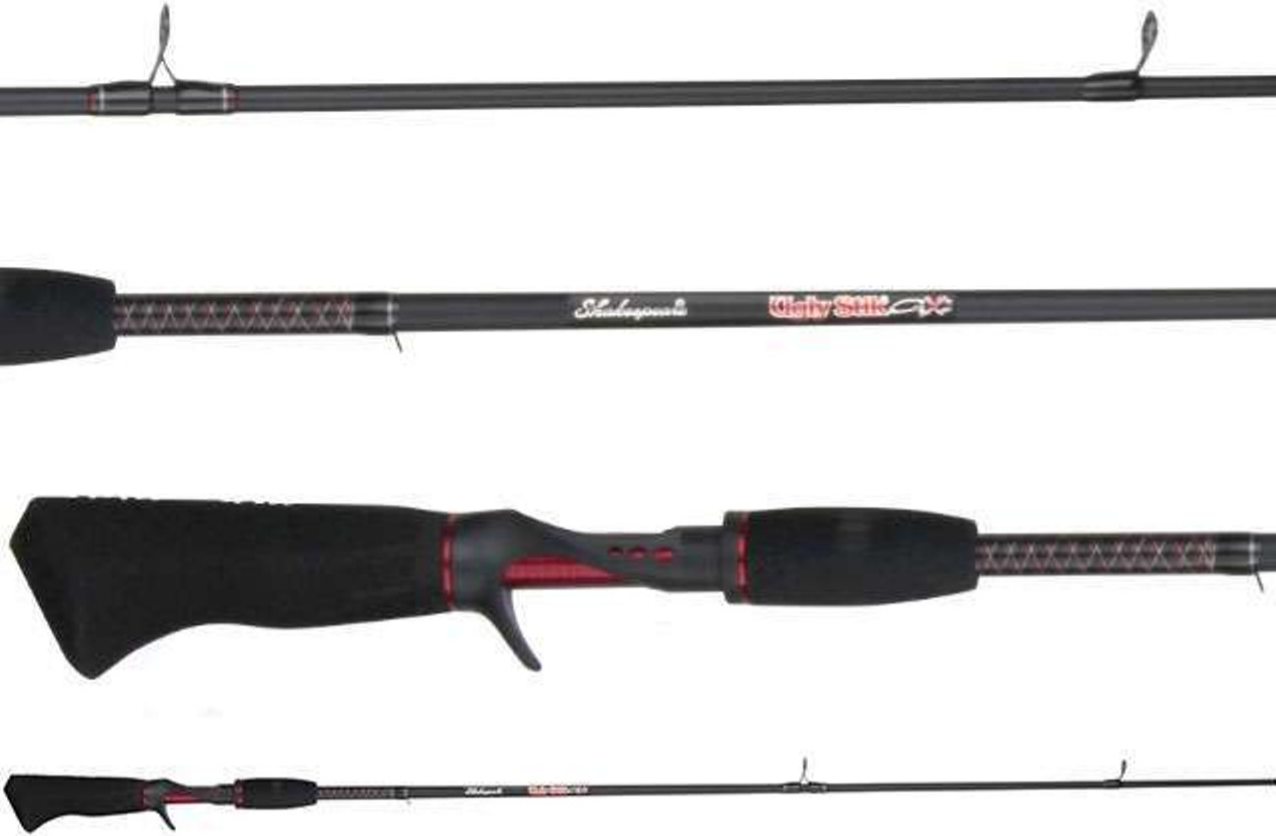 |  | 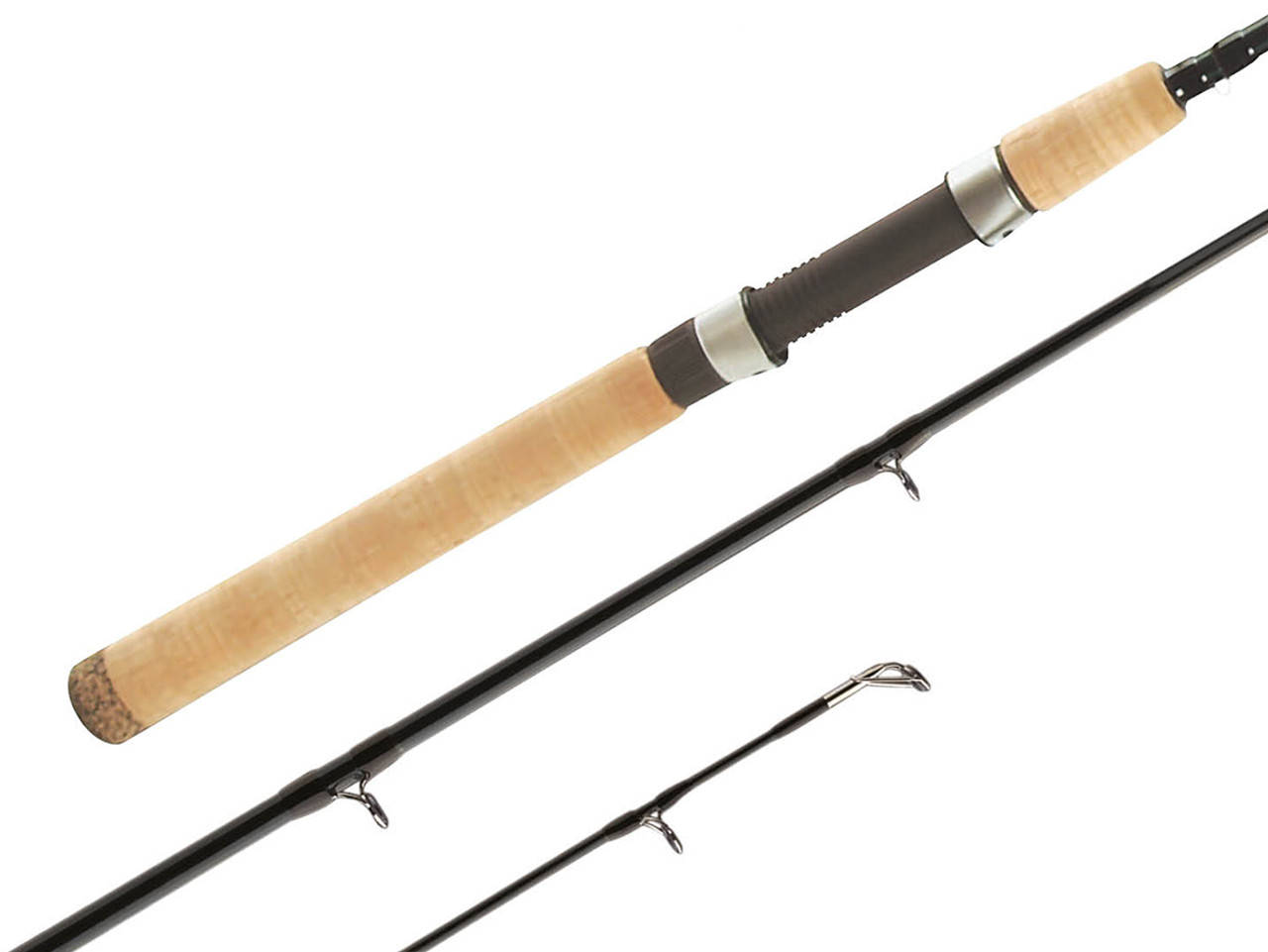 | |
| This rod is a great all-around option that is both durable and sensitive. | This rod is designed for maximum sensitivity and features a high-quality graphite blank construction. | This rod is made with high-quality materials and features a powerful blank construction that provides excellent sensitivity and strength | This rod is designed for inshore saltwater fishing and features a high-quality graphite blank construction that provides excellent sensitivity and strength. |
| SEE REVIEWS | SEE REVIEWS | SEE REVIEWS | SEE REVIEWS |
Frequently Asked Questions About Saltwater Fishing Rods
What is the difference between a saltwater fishing rod and a freshwater fishing rod?
Saltwater fishing rods are designed to withstand the corrosive effects of saltwater and are typically more robust and durable compared to freshwater rods.
What is the ideal length for a saltwater fishing rod?
The ideal length depends on the type of fishing and location, but generally, saltwater rods range from 7 to 12 feet. Longer rods are often used for surf fishing, while shorter ones are suitable for boat fishing.

What is the difference between a spinning rod and a casting rod for saltwater fishing?
Spinning rods are generally easier to use for beginners, while casting rods offer more accuracy and power. The choice depends on personal preference and the specific fishing technique.
What materials are commonly used in saltwater fishing rod construction?
Common materials include graphite, fiberglass, and composite blends. Graphite rods are lighter and more sensitive, while fiberglass provides greater durability.
How important is rod power in saltwater fishing?
Rod power indicates its strength. Light power for smaller fish, medium power for a versatile range, and heavy power for large and powerful fish like marlin or tuna.

What does “action” refer to in a saltwater fishing rod?
Rod action defines where the rod flexes and how quickly it returns to its original position. Fast action provides sensitivity, while slow action offers more flexibility.
Can I use the same rod for inshore and offshore saltwater fishing?
It depends on the specific requirements, but some rods are versatile enough to handle both inshore and offshore fishing. Consider the target species and fishing conditions.
How do I choose the right rod for a specific saltwater species?
Consider the size and strength of the target species. Light rods for smaller fish, medium for general use, and heavy for larger game fish.
Is it necessary to rinse my saltwater fishing rod after each use?
Yes, rinsing your rod with freshwater after each use helps remove salt residue, preventing corrosion and extending the rod’s lifespan.
What maintenance is required for saltwater fishing rods?
Regularly inspect guides, reel seats, and rod blanks for any signs of damage. Clean with mild soap and water, and store in a protective rod case when not in use.
Saltwater Fishing Rods: What’s Best for You?
Saltwater fishing rods are specialized tools designed to handle the unique challenges of saltwater fishing. Choosing the right saltwater fishing rod is essential for any angler. Whether you’re a beginner or an experienced fisherman, there are many factors to consider when selecting a rod.
When choosing a saltwater fishing rod, consider the type of fishing you’ll be doing, the size and strength of the fish you’ll be targeting, and the length and action of the rod. You will want to choose a high-quality saltwater fishing rod that meets your needs based on your experience level, budget, and preferred style of fishing.
By understanding the different types of rods, materials, and components available, you can make an informed decision that will help you catch more fish and enjoy your time on the water. And, With the right rod in hand, you’ll be well-equipped to tackle whatever the ocean throws your way.
As always, stay safe, enjoy the journey and please try to leave it cleaner than you found it. If you have any comments, questions, ideas, or suggestions please leave them in the comment section below and I’ll get back to you ASAP. You can follow us on Facebook: Rex The Beach Angler, Instagram: thebeachangler7, Twitter: @AnglerBeach, and YouTube: Man Art Creations.

P.S. – Thanks so much for checking out our blog we really appreciate it. Just so you know, we may receive a commission if you click on some of the links that appear on our site. This helps us keep our content free and up-to-date for everyone. We appreciate your support!
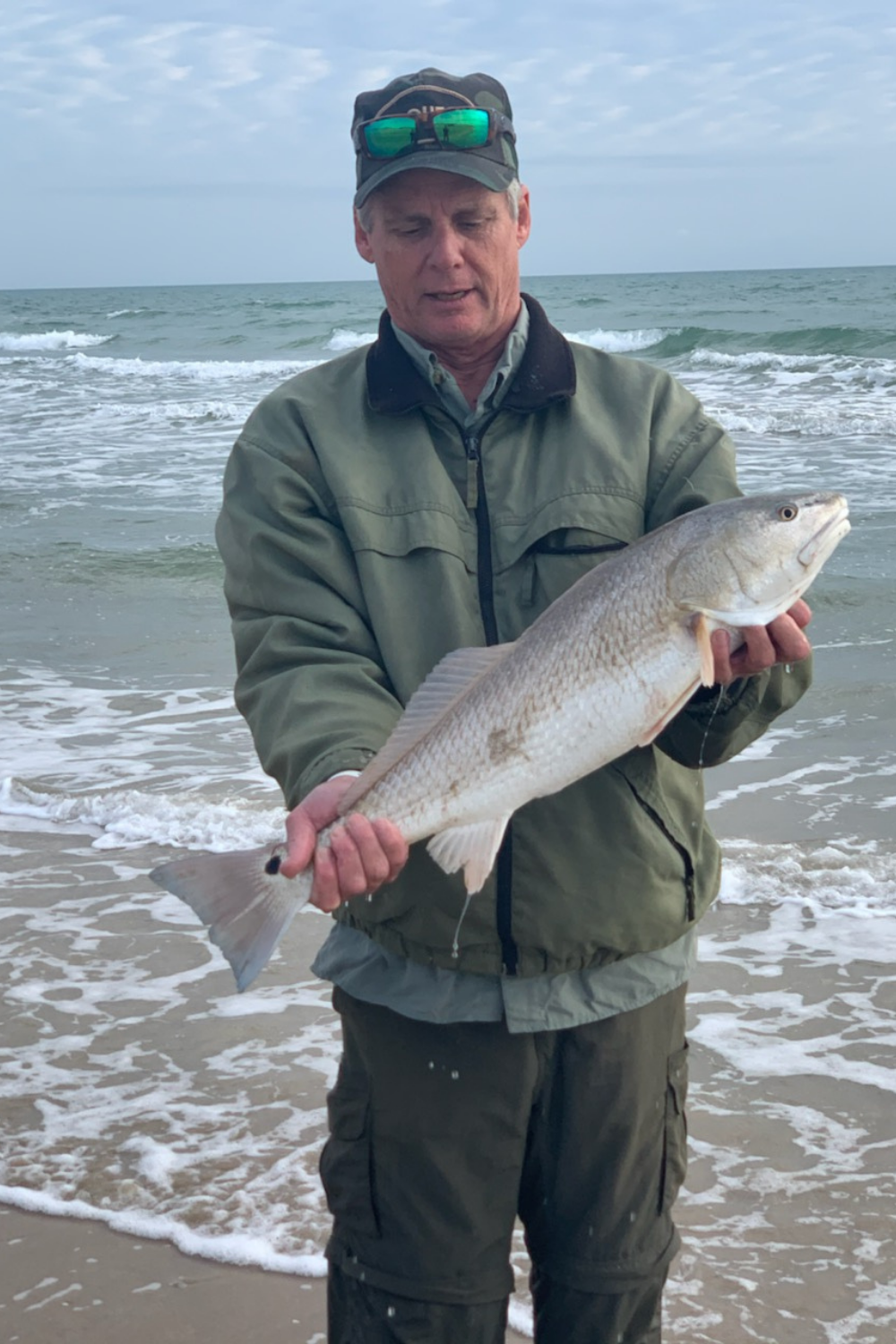
A life long surf fisherman with 50+ years of experience, I am also an avid hunter and outdoorsman. I will be sharing my passion for the outdoors with you so be prepared for hunting, fishing, camping, hiking and more. Along with gear reviews and the latest trends and innovations in the outdoor industry.
